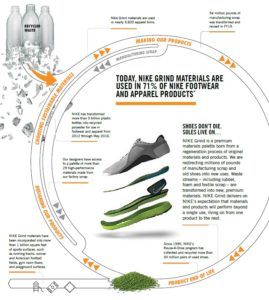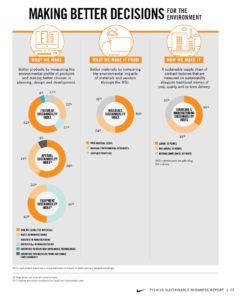Nike’s Path to Sustainability

Nike is implementing a sustainability plan with ambitious goals to achieve by 2020.
Nike manufactures athletic apparel and distributes the apparel through its own retail channels as well as other retailers. Therefore, Nike relies on a vast array of raw materials and chemical components as inputs for the production process, making Nike vulnerable to climate change in two ways:
1.Supply shortages and price increases of raw materials due to natural disasters or changes in weather pattern
2.Heavy reliance on electricity and water for manufacturing, distribution and retail centers. Regulations on greenhouse gas emissions will impact the price of electricity and fuel, and drought may reduce the availability of water, thus either reducing supply or increasing the cost of these inputs.
If Nike does not address these vulnerabilities, it risks rising production costs, which would reduce margin or be passed down to the consumer, thus affecting product competitiveness. In addition, large companies like Nike are also increasingly facing pressure from the government and the public to become more sustainable and to reduce environmental impact.
Nike has already taken significant steps into that direction. In 2013, “PlanetSave” identified Nike as “the greenest soccer shoe around” , praising the company for going above and beyond in supporting sustainable production and protecting the environment. Nike is following an ambitious plan with specific targets for 2020. Based on its report and its website , Nike is taking the following measures to mitigate its environmental impact and to make production more sustainable:
1.Product scoring to determine the environmental impact of producing each product, which in turn informs the product design and iteration process.2,3
2.Waste reduction through more efficient product design and manufacturing practices, such as re-using scrap to build new products, as further illustrated in Exhibit 1.(2) In FY2015, “4 million pounds of factory scrap was transformed into premium materials used in Nike performance footwear and apparel.” (2,3)
3.Energy efficiency through its Energy and Carbon Program to reduce energy use per unit every year. From 2008 to today, Nike managed to cut energy use per unit by 50%. Nike also has the ambitious goal of obtaining 100% of its energy through renewable sources (owned or operated) by FY2025. (2,3)
4.Water efficiency- Nike also managed to reduce water use by “18% per unit in apparel materials and 43% per unit in footwear” which “far surpassed” the company’s FY2015 goals. (2,3) Furthermore, it uses innovative technologies such as its “ColorDry” technology “which dyes fabrics using zero water, [which] has saved more than 20 billion liters of water” since 2010.(4)
5.Use of chemicals and innovative materials- Nike established a “restricted substance list” and is developing an array of sustainable materials, such as products that contain fewer and less harmful chemicals to protect environmental pollution.(2,3)
6. Culture of innovation and information sharing- Nike is collaborating with several external entities (e.g. MIT’s Climate Co Lab) to determine sustainability of different materials as well as “new ideas on how to engage industries, designers and consumers to value, demand and adopt low-impact materials.” (2,3)
As outlined above, Nike is already taking significant steps to reduce its environmental impact. However, based on the information provided as well as Exhibit 2 below, it seems that Nike is focusing mostly on the factors within its own control, such as improving product design and manufacturing practices. In reality, Nike is part of a supply chain with many raw material suppliers as well as distributors. Hence, I believe Nike could take additional steps to work its channel partners to further reduce environmental impact throughout the entire supply chain. First, it can select raw material suppliers based on the suppliers’ efficient and sustainable use of resources. Second, it can partner with distributors to reduce the environmental impact of transporting raw materials to factories and finished goods from factories to stores. Furthermore, Nike could work on its own stores to make them more sustainable (e.g., reducing energy consumption, using eco-friendly shopping bags). As an industry leader, Nike could serve as a mentor to its supply chain partners, while also being an industry leader in the types of measures and standards used to measure sustainability efforts.
Exhibit 1: Sustainability in Nike’s product design process

Exhibit 2: Steps Nike is taking to improve environmental footprint

Written sources:
1 PlanetSave “10 Companies with Eco-Conscious Production Processes”, June 21, 2013
2 “Sustainable Innovation is a Powerful Engine for Growth”, Nike’s websiSustainability Business Report, FY14/15
3 Nike website:http://about.nike.com/pages/environmental-impact, last accessed 11/02/2016
4 Nike website: http://news.nike.com/news/sustainable-innovation, last accessed 11/02/2016
Exhibit sources:
Exhibit 1 &2: “Sustainable Innovation is a Powerful Engine for Growth”, Nike’s websiSustainability Business Report, FY14/15
Cover picture: http://about.nike.com/pages/sustainableinnovation
Word count: 732 words



It’s interesting to me that despite Nike being one of the greatest marketing brands in the world, they don’t market any of these sustainable practices. We learned in our marketing case on Nike that they are reluctant to do so for fear of cheapening the brand or they could be fearful of being accused of “greenwashing” like we learned in our Ikea case. However, as consumers become more conscious of the environmental impact of the products they buy, I wonder if this could become a competitive advantage for Nike. Adidas is already beginning to encroach in this space. They just released a prototype 3D-printed sneaker made from recycled ocean plastic and are putting a lot of PR behind this with a competition to win the sneakers: http://www.theverge.com/2016/6/8/11881670/adidas-3d-printed-sneaker-competition
Nike got into trouble a few years ago because of their labor practices in their factories, but I don’t think many consumers know that they’ve raised their standards. Their sustainability initiative could be another way to assure consumers that they are an industry leader when it comes to corporate responsibility.
I agree with this post, as Nike has made significant efforts to become “greener”. However, I deem that as an industry leader, Nike must not only serve as a mentor to its supply chain partners, but also as a mentor to its customers. A company with the brand awareness that Nike has is able to influence a very significant number of people once it publicly supports a given cause, in particular if it gets one of its athletes to join that cause – see the example of LiveStrong, which was able to sell 80 million bracelets to help fight cancer with the help of Lance Armstrong and Nike, among other partners. I believe that, if Nike truly values the fight against climate change, it should promote campaigns that raise awareness and/or funds at a global level, leveraging on its athletes – Cristiano Ronaldo offered to help his native Madeira island after last summer’s forest fires significantly destroyed the area; a campaign with Nike and Cristiano Ronaldo about climate change would have an enormous impact on the awareness of the world for this issue, could easily become viral, and be able to raise funds to help fighting climate change.
I agree with the questions and thoughts the author poses to Nike. As an industry and market leader, efforts on reducing greenhouse gas emission should be spent both within the company and across the entire product value chain. Taking the example of Unilever, a leading player in its own field, Unilever brought up the concept of reducing greenhouse gas emission throughout is value chain – raw material sourcing, manufacture, distributor, consumer use and disposal (https://www.youtube.com/watch?v=cpYhgqPRivw).
Other than that, I also think breaking down the sources of GHG emission would help Nike to focus its efforts and achieve better results. Looking at the sources (https://www.statista.com/statistics/551572/ghg-emissions-from-nike-by-segment/), “footwear manufacturing” and “inbound logistics” are clearly two biggest drivers and we shall expect more actions in those two components.
Great Post! It’s great to see Nike taking a stand! I am curious to see your thoughts on Nike taking a strategic stake in DyeCoo Textile Systems (a Netherlands-based company) that has “developed the technology to replace water, normally used for dyeing, with recyclable CO2, reducing energy use and ending the need for added chemicals” [1]. It’s interesting to see Nike looking to take stakes in companies that affect their supply chain as it allows for more control over where the materials for their shoes are coming from. This stake in DyeCoo is expected to have major impact on Asia where much of the demand for dying of textiles occurs [1]. Do you think Nike should continue this strategic behavior to work towards their climate change goals? Should Nike help DyeCoo open more offices to help other companies with their environmental goals?
[1] Kirsten Korosec, “Nike’s Waterless Dye Factory Cuts Energy Use 60%,” Fortune, December 3, 2013, http://www.environmentalleader.com/2013/12/03/nikes-waterless-dye-factory-cuts-energy-use-60/#ixzz4PHrWXa5z, accessed November 2016.
Great post, Hannah! I completely agree with you that Nike has a responsibility to influence sustainable practices throughout its entire supply chain. A few years back, Kering did a great Environmental P&L study on Puma, and found that raw materials are by far the greatest impact an apparel company has on the environment. Nike also acknowledges this in its sustainability report: “The materials used in our products – from growing crops to manufacturing finished goods – have the greatest environmental impact in the entire product life cycle, so reducing this impact is among the strongest levers we have for improving our overall environmental performance.” That being said – I am not convinced that they are acting quickly enough in regards to their raw materials. In 2015, only 26% of the cotton used by Nike Inc was organic, recycled, or Better Cotton Initiative (BCI) certified, and only 17% of polyester purchased by Nike Inc. was recycled. I am curious whether the predominant constraint around converting their materials faster is price or availability.